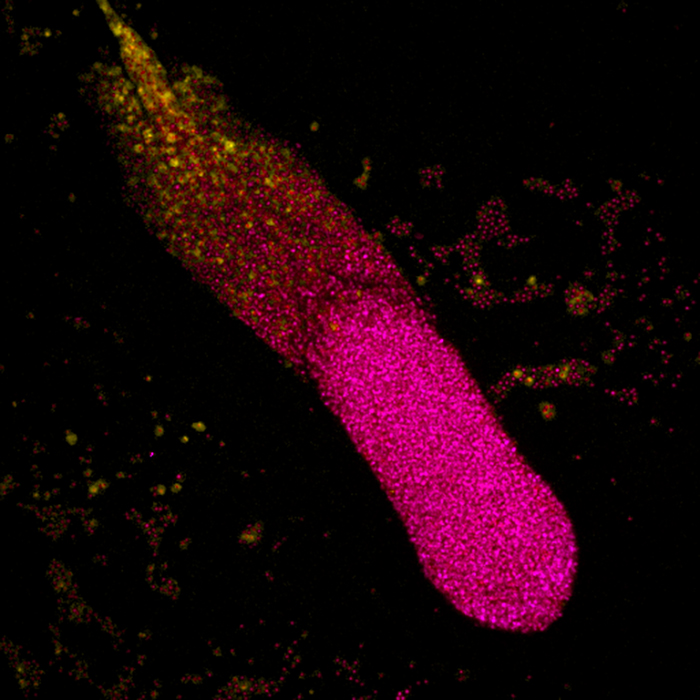Vlatka Antolovic and Agnes Miermont on their recent publication in Development
Vlatka Antolovic and Agnes Miermont of the Chubb Lab tell us about their recent publication in Development, where they examine the effects of spontaneous DNA damage on cell fate choice.
What discoveries led you to the research described in your publication?
Vlatka: We were looking for sources of heterogeneity in gene expression during the early development and noticed that rad51 expression was extremely variable. So, we decided to follow this up; we initially tested whether this is a signature of spontaneously occurring DNA damage and then used this signature to track these cells throughout the development.
What were you trying to understand?
Vlatka: We were interested in the fate “choice” of the cells experiencing spontaneous DNA damage at the onset of development. Do the damaged cells get utilised during development like an unperturbed cell?
Agnes: Cells are naturally subjected to environmental stresses which can lead to DNA damage. DNA repair mechanisms are therefore critical to maintain DNA integrity and normal cell activity. Despite extensive study on cell protective response to DNA damaging treatment, not much is known concerning spontaneously occurring damaged cells, especially at the onset of development. During development, decision making can be highly dependent on the initial molecular states of cells; therefore, Vlatka and I were wondering what would be the behaviour and subsequent fate of cells subjected to spontaneous DNA stress during cell-fate decision.
Why is this important?
Vlatka: The very act of DNA replication is not an error-free process. Meaning, in a perfectly fine environment, a cell may still experience spontaneous DNA damage and is evolutionarily equipped to resolve this error. However, what happens in unfavourable situations, like the one where food-depleted population of Dictyostelium cells initiates development into a multicellular life form and needs to sacrifice 20% of its population to support structures consisting entirely of dead cells? Is there a selection ensuring the least fit cells are more likely to be sacrificed?
Agnes: Development is a precise multi-step process where DNA integrity is essential for proper multicellular organism formation. For instance, it is well known that DNA repair activity in the zygote is mandatory to avoid mutations in the germ line. However the fate of cells undergoing repair processes is unclear. Do the repair processes allow cells to recover decision-making capacity to the same extent as unstressed cells? Or are there extra protective mechanisms which exclude or restrain stressed cells to less critical developmental fates? Therefore a better understanding of the cell expression heterogeneities at the onset of development - especially regarding DNA repair mechanisms - is important to understand how multicellular organisms are being shaped.
Can you use an analogy to help me understand your work?
Agnes: Imagine a dance performance consisting of many figures executing a sophisticated choreography and finishing in a complex arrangement (e.g. a human pyramid). Early during the show, one of the dancer becomes sick. Knowing that he is not in top shape, we suspect he will not move as fast nor as well as his companions. So our main question is - to which extent is one dancer’s performance essential for the success of the show? We could ask if he will make the decision to communicate his troubles to his fellow dancers, and if yes, will he manage to be quiet enough not to disturb the overall choreography? We could also wonder if the energy and flow of dancers will motivate him to continue until the end, or on the contrary, to exit the stage at early as possible. Finally if he manages to cope with his sickness, will he still have enough strength to be part of the human pyramid or will he decide to stay at the back?
What questions remain to be asked?
Vlatka: We have shown here how several different mechanisms seem to direct cells either toward the stalk fate or to be shed completely from the multicellular structure. The mechanisms which marginalise sick cells include weakened cell-cell adhesion and a block in the spore differentiation program. It will be interesting to know how the DNA damage signal is propagated within the cell so as to affect these processes.
Agnes: Our approach is suitable to study the behaviour of rare cell populations during development. We could therefore ask if the conclusions obtained on spontaneous DNA repair mechanisms could be applied to other forms of stress, but also to any other source of expression heterogeneity.
Written by Vlatka Antolovic and Agnes Miermont
 Close
Close


